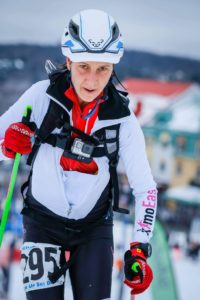By Nicolas Fréret, trainer and assistant editor-in-chief, Distances+
Just because it’s winter doesn’t mean you must fear the cold; go on, get out there and run! At least, that’s the unanimous view of three experienced runners: the athlete Lyne Bessette, the comedienne Geneviève Gagnon, and Josée Prévost, owner of the Maison de la course stores. We asked them what gear and apparel are ideal for winter running in Quebec and, above all, for Tremblant’s 24h, regardless of the elements.

credit photo: Nancy Létourneau
Josée Prévost recommends starting your training program when winter first begins to give yourself time to adapt gradually to the cold. “The first time out is always hard, but you get used to it,” she says.
“I find that people are often overdressed when they run, even when it’s very cold outside,” observes Lyne Bessette.
Geneviève Gagnon agrees. “Runs are not as good when you’re overdressed.” The comic, who’s also known by the alias “Cours Toutoune,” strives to dispel the sacred aura around running with her YouTube videos. “People are afraid they’ll be cold, but I tell them they’ll warm up in no time and feel just fine.”
As it happens, “we have a built-in thermoregulatory system,” notes Prévost. When it kicks in, it produces heat and maintains it as long as the body is in motion. Still, it is important to protect the ears, neck, hands and feet, as the system has its priorities – primarily, maintaining the temperature of internal organs at 37 degrees Celsius. Our extremities, such as fingers and toes, are “sacrificed” in this mission.
Upper body protection
Runners generally abide by the rule of three layers when temperatures drop below freezing.
The idea is to layer three technical garments: the first layer against the skin, in a fabric that breathes and wicks away perspiration to keep the body dry; the second, which ensures thermal insulation to keep cold out and prevent heat from escaping; and the third, which is waterproof and windproof.
Lower body protection
“It is best to wear pants made from a fabric that is windproof at the front and breathable in the back,” advises Josée Prévost.
Former cycling champion Lyne Bessette, who spends her winters ski mountaineering (or “skimo”), likes “leggings that are aren’t too thick, because I like to feel like I’m naked when I run.”
Men tend to appreciate protection in the groin area, with some opting for windproof boxers over their tights, while women dress to avoid getting cold buttocks, notes Josée Prévost. “The latest fashion is a windproof fleece skirt. I recommend it only in extremely cold weather – say, when it’s minus 20 outside,” she adds.
At that temperature, Geneviève Gagnon swears by merino wool or polar fleece garments. “Merino is expensive, but you’ll keep it a long time,” she promises. Still, a word about the percentage of merino wool in technical apparel (it will be indicated on the product packaging) sold mostly in specialty stores: the higher the wool content, the warmer you’ll feel.
Protecting the head
A tuque that covers the forehead and ears, along with a tube for the neck, are winter essentials. Another good option in very cold temperatures is a balaclava with a mesh over the nose for breathing – in spite of the fact that “you’ll look like a bank robber,” jokes Josée Prévost.
“Don’t over-cover the head,” cautions Geneviève Gagnon. “You want a small, technical tuque that breathes, not a big woollen job. That’s just ridiculous!”

credit photo: Courtoisie
Lyne Bessette says she never goes running without a scarf, which she pulls over her mouth periodically to warm her breath when she needs to.
Lastly, Josée Prévost strongly recommends a quality cold-weather crème for the face, hands and feet – she likes “Cold” by Akileine.
Hand protection
Wearing gloves while running is good – if you can find a pair that keeps them warm, that is – but running with mittens, which keep the fingers pressed together, is better, says Josée Prévost.
She adds a couple of helpful tips: “Take your mittens off for a minute now and then to eliminate moisture. And, to keep hands warm, flex and clench the fingers several times in a row.”
The right footwear
In Quebec, we deal with snow, ice and slush. So we want a shoe with a waterproof liner and lugged soles, suggests Josée. “On the other hand, the foot can become sweat-soaked, so these aren’t recommended for high-intensity training.” In that case, it’s better to go with a well-ventilated shoe, like classic trail runners. Paired with a good-quality merino wool sock, these are good in most conditions.”
To run even in freezing rain, “the only solution is shoes with metal lugs or crampons that strap onto the shoe. They are somewhat less comfortable, but sometimes it’s what you need to run safely.”
Running and safety
If you run in the morning or at night, chances are it’s dark outside. A headlamp is recommended to help you see. To be seen by others, you should wear a reflective armband or fluorescent jacket.
If your budget permits, you can complete your winter running gear with a pair of anti-fog sunglasses.
All of the experts agree: there is no reason not to run in the winter. You just need to adapt to wintry elements with the right garments and good advice. Thus armed, winter training will always be a real pleasure.





